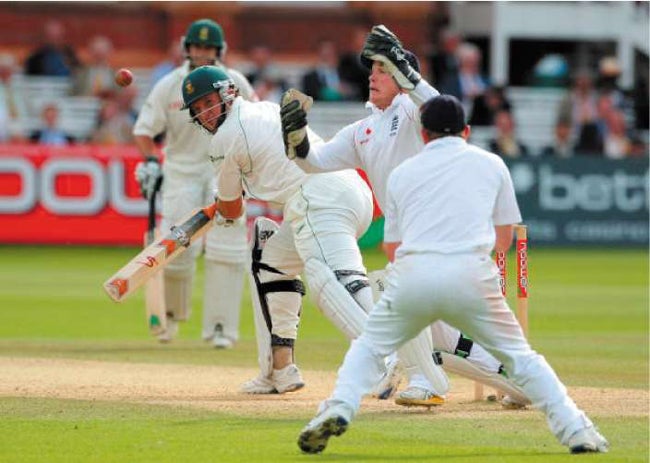Bowlers toil in vain on familiar trudge down Lord's cul-de-sac

Lord's is the home of cricket, but recently it has been anything but a sweet place for the England team. The failure of Michael Vaughan's men to take a single wicket during the first two and half sessions yesterday appeared to suggest that they are stuck in some awful groundhog day of their own.
The last five Tests at Lord's have seen England take a firm grip on the match with a fine first innings showing with the bat, and more especially with the ball, only to find that second time around the would-be vanquished have managed to fight back and force a draw. This deep rut was first ploughed two years ago against Sri Lanka, when England piled up 500-plus runs, dismissed the tourists to take a 359-run lead and enforced the follow-on.
That same season, 2006, saw them amass another big score against Pakistan. No follow-on this time but the bowlers were only able to pick up four second innings wickets, so that too petered out into a draw.
The following year it was the same story in another high-scoring game against the West Indies. Against India later that summer England almost bucked the trend reducing them to 282 for 9, but that final wicket just eluded the toiling attack. Upshot? Another draw.
If England's supporters expected a change in their team's luck in 2008, they were soon disabused of the notion. In the first match here against New Zealand the Kiwi batsmen proved as stubborn to remove as everyone else. And so to South Africa. The Proteas' record here has been exceptionally good. They won their first three Tests at Headquarters following their readmission to the world game. With that behind them perhaps it should have been expected that there would be a ferocious fightback after their disappointing showing in the first innings which enabled England to enforce the follow-on.
But there is another common factor running through these recent Lord's Tests. In five out of these last six Test matches over the last three seasons England have shown up at Lord's armed with a four-man bowling attack, with Paul Collingwood as a fifth option and no Andrew Flintoff.
The exception was the Test against Sri Lanka in 2006, when they fielded a five-man attack that included Flintoff, but even then the pitch proved to be the winner. In Sri Lanka's second innings England bowled 199 overs with Flintoff sending down a staggering 51 of them, a workload that contributed to his chronic ankle condition and he did not play another Test that season.
This time around it has not been for want of trying on the part of the England bowlers. Yesterday they stuck admirably to their task, but there just seems to be a contrary streak running through this ground.
And it does seem to be a problem that is peculiar to Thomas Lord's old ground. Take Headingley for example. When England beat Pakistan in Leeds two years ago, and triumphed against the West Indies there a year later in 2007, they fielded a four-man attack.
But, as ever, Lord's is something different, something special. It would appear that England have to start with a five-man attack, so that the load can be spread around better and give the captain Vaughan a broader choice.
That would also allow the bowlers to be used in shorter spells. Those spells would therefore be sharper because the bowlers would be that much fresher. Vaughan would also be able to mix it up a bit more, thus unsettling the batsmen. Then maybe the wickets, and the wins, will come.
Subscribe to Independent Premium to bookmark this article
Want to bookmark your favourite articles and stories to read or reference later? Start your Independent Premium subscription today.

Join our commenting forum
Join thought-provoking conversations, follow other Independent readers and see their replies